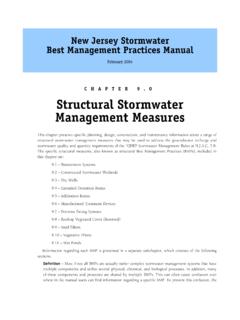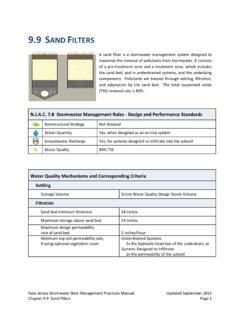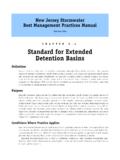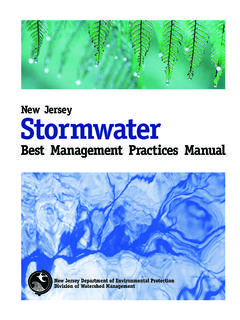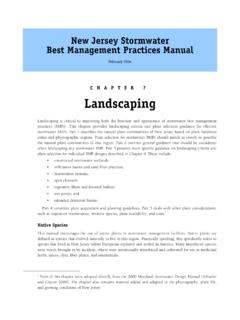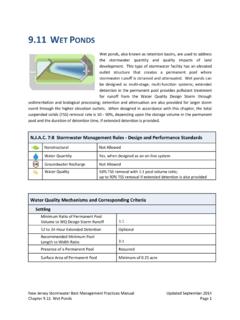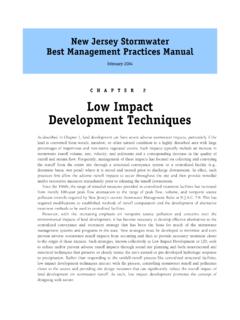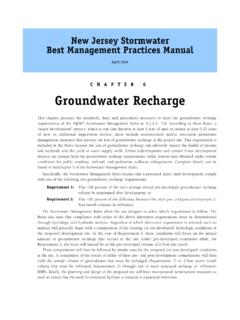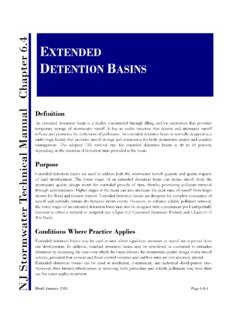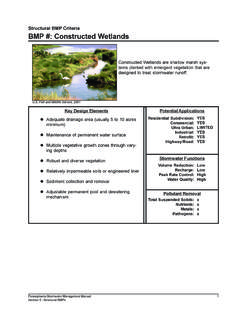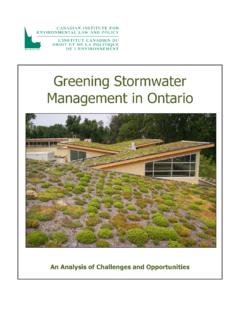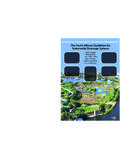Transcription of CONSTRUCTED STORMWATER WETLANDS
1 Draft February 2011 Page Definition CONSTRUCTED STORMWATER WETLANDS are wetland systems designed to maximize the removal of pollutants from STORMWATER runoff through settling and both uptake and filtering by vegetation. CONSTRUCTED STORMWATER WETLANDS temporarily store runoff in relatively shallow pools that support conditions suitable for the growth of wetland plants. There are two types of CONSTRUCTED WETLANDS for STORMWATER runoff treatment: standard WETLANDS and and subsurface gravel WETLANDS . Standard CONSTRUCTED WETLANDS direct flow through an open vegetated marsh system. Subsurface gravel WETLANDS , also direct flow through a surface marsh which then discharges to a permanently ponded subsurface gravel bed. The TSS removal rate for CONSTRUCTED STORMWATER WETLANDS is 90.
2 Purpose CONSTRUCTED STORMWATER WETLANDS are used to remove a wide range of STORMWATER pollutants from land development sites as well as provide wildlife habitat and aesthetic features. CONSTRUCTED STORMWATER WETLANDS can also be used to reduce peak runoff rates when designed as a multi-stage, multi-function facility. Conditions Where Practice Applies Standard CONSTRUCTED WETLANDS require sufficient drainage areas and dry weather base flows to function properly. The minimum drainage area to a CONSTRUCTED STORMWATER wetland is 10 to 25 acres, depending on the type of wetland . The depth to the SHWT must be considered as part of the water budget evaluation. See E below for additional information. Subsurface gravel WETLANDS (SGW) do not have a minimum drainage area requirement.
3 They are well suited for retrofit applications since draindown through the subsoil is not required to provide water quality treatment and the hydraulic head requirement is smaller than that of standard WETLANDS . In addition, gravel WETLANDS are not dependent on the depth to the seasonal high water table (SHWT.) SGW can be placed within the footprint of an existing STORMWATER BMP to enhance the water quality function of the BMP, and is particularly effective in nitrogen removal. CONSTRUCTED STORMWATER WETLANDS Draft February 2011 Page CONSTRUCTED WETLANDS should not be located within natural wetland areas since they will typically not have the same full range of ecological functions. While providing some habitat and aesthetic values, CONSTRUCTED STORMWATER WETLANDS are designed primarily for pollutant removal.
4 Finally, a CONSTRUCTED STORMWATER wetland must have a maintenance plan and, if privately owned, should be protected by easement, deed restriction, ordinance, or other legal measures that prevent its neglect, adverse alteration, and removal. Design Criteria The basic design parameters for any type of CONSTRUCTED wetland are the storage volumes within its various zones. In general, the total volume within these zones must be equal to the design runoff volume. An exception to this requirement is the standard WETLANDS with extended detention. In addition, the character, diversity, and hardiness of the wetland vegetation must be sufficient to provide adequate pollutant removal. Selected of vegetation must be non-invasive and based on the anticipated water depth within the WETLANDS .
5 (Additional information is provided in Chapter XX: Landscaping.) A CONSTRUCTED wetland must be able to maintain its permanent pool level. If the soil at the surface of a wetland site is not sufficiently impermeable to prevent excessive seepage, construction of an impermeable liner or other soil modifications will be necessary. Details of these and other design parameters are presented below. A. Standard WETLANDS Standard WETLANDS typically consist of three zones: pool, marsh, and semi-wet. Depending upon their relative size and the normal or dry weather depth of standing water, the pool zone may be further characterized as a pond, micropond, or forebay. Similarly, the marsh zone may be further characterized as either high or low marsh based again upon the normal standing water depth in each.
6 Depending on the presence and relative storage volume of the pool, marsh, and semi-wet zones, a standard wetland may be considered to be one of three types: pond wetland , marsh wetland , or extended detention wetland . As described in detail below, a pond wetland consists primarily of a relatively deep pool with a smaller marsh zone outside it. Conversely, a marsh wetland has a greater area of marsh than pool zone. Finally, an extended detention wetland consists of both pool and marsh zones within an extended detention basin. Table below presents pertinent design criteria for each type of standard CONSTRUCTED wetland . As shown in the table, each type ( , pond, marsh, and extended detention wetland ) allocates different percentages of the total STORMWATER quality design storm runoff volume to its pool, marsh, and semi-wet zones.
7 In a pond wetland , this volume is distributed 70 percent to 30 percent between the pool and marsh zones. Conversely, in a marsh wetland , the total runoff volume is distributed 30 percent to 70 percent between the pool and marsh zones. Both of these zone volumes are based on their normal standing water level. However, in an extended detention wetland , only 50 percent of the STORMWATER quality design storm runoff volume is allocated to the pool and wetland zones, with 40 percent of this amount (or 20 percent of the total STORMWATER quality design storm runoff volume) provided in the pool zone and 60 percent (or Draft February 2011 Page 30 percent of the total runoff volume) provided in the marsh zone. The remaining 50 percent of the STORMWATER quality design storm runoff volume is provided in the wetland s semi-wet zone above the normal standing water level, where it is temporarily stored and slowly released similar to an extended detention basin.
8 As noted in Table , the detention time in the semi-wet zone of an extended detention wetland must meet a minimum of 24-hour detention time, which is the time from when the maximum storage volume is achieved until only 10 percent of the maximum volume remains in an extended detention wetland . The minimum diameter of any outlet orifice in all wetland types is inches. The components of a typical standard STORMWATER wetland are illustrated in Figure Pertinent design criteria for each component are presented in Table Additional details of each type of CONSTRUCTED STORMWATER wetland and the components of each are described below. 1. Pool Zone Pools have standing water depths of 2 to 6 feet and primarily support submerged and floating vegetation.
9 Due to their depths, support for emergent vegetation is normally limited. As noted above, the pool zone consists of a pond, micropond, and/or forebay, depending on their relative sizes and depths. Descriptions of the pond and micropond are presented below. See C. Forebays for a discussion of the forebay zone. a. Pond Ponds have standing water depths of 4 to 6 feet and, depending on the type, can comprise the largest portion of a CONSTRUCTED STORMWATER wetland . Ponds provide for the majority of particulate settling in a CONSTRUCTED STORMWATER wetland . b. Micropond Microponds have a standing water depth of 4 to 6 feet, but are smaller in surface area than a standard pond. A micropond is normally located immediately upstream of the outlet from a CONSTRUCTED STORMWATER wetland .
10 At that location, it both protects the outlet from clogging by debris and provides some degree of particulate settling. Since a micropond does not provide the same degree of settling as a standard pond, it is normally combined with a larger area of marsh than a standard pond. Draft February 2011 Page Table 1: Design Criteria for Standard CONSTRUCTED WETLANDS 2. Marsh Zone Marshes have shallower standing water depths than ponds, generally ranging from 6 to 18 inches. At such depths, they primarily support emergent wetland vegetation. As noted above, a marsh is classified as either a high or low marsh, depending on the exact depth of standing water. a. Low Marsh A low marsh has a standing water depth of 6 to 18 inches. It is suitable for the growth of several emergent wetland plant species.
